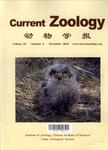Orbit orientation in didelphid marsupials (Didelphimorphia: Didelphidae)
Orbit orientation in didelphid marsupials (Didelphimorphia: Didelphidae)作者机构:Laboratorio de Mastozoologia Departamento de Zoologia Universidade Federal de Pernambuco. Av. Prof. Moraes Rego S/N Cidade Universitaria Recife PE 50670-901 Brazil
出 版 物:《Current Zoology》 (动物学报(英文版))
年 卷 期:2017年第63卷第4期
页 面:403-415页
核心收录:
学科分类:0710[理学-生物学] 07[理学] 08[工学] 0814[工学-土木工程] 071002[理学-动物学] 082301[工学-道路与铁道工程] 0823[工学-交通运输工程]
基 金:Data collection was supported by a doctoral fellowship to D.A. from Fundacao de Amparo a Pesquisa do Estado de Sao Paulo by grants from Fundacao de Amparo a Ciencia e Tecnologia do Estado de Pernambuco a Grant-in-Aid of Research from the American Society of Mammalogists supported by a Research Fellowship from Conselho Nacional de Desenvolvimento Cientifico e Tecnologico
主 题:convergence Didelphidae frontation orbit orientation verticality.
摘 要:Usually considered a morphologically conservative group, didelphid marsupials present consider- able variation in ecology and body size, some of which were shown to relate to morphological structures. Thus, changes on orbit morphology are likely and could be related to that variation. We calculated orbit orientation in 873 specimens of 16 Didelphidae genera yielding estimates of orbits convergence (their position relative to midsagittal line) and verticality (their position relative to frontal plane). We then compared similarities in these variables across taxa to ecological, morpho- logical and phylogenetic data to evaluate the influencing factors on orbit orientation in didelphids. We found an inverse relation between convergence and verticality. Didelphids orbits have low ver- ticality but are highly convergent, yet orbit orientation differs significantly between taxa, and that variation is related to morphological aspects of the cranium. Rostral variables are the only morpho- logical features correlated with orbit orientation: increasing snout length yields more convergent orbits, whereas increase on snout breadth imply in more vertical orbits. Size and encephalization quotients are uncorrelated with orbit orientation. Among ecological data, diet showed significant correlation whereas locomotion is the factor that less affects the position of orbits. Phylogeny is uncorrelated to any orbital parameters measured. Ecological factors seemingly play a more import- ant role on orbit orientation than previously expected, and differentiation on orbit orientation seems to be more functional than inherited. Thus, despite the apparent homogeneity on didelphid morphology, there is subtle morphological variability that may be directly related to feeding behavior.



